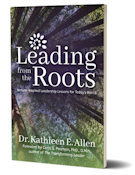
What Can Nature Teach Us About Resilience and Diversity?
By Dr. Kathleen Allen (Dr. Allen will be a part of the 2019 Lideramos Webinar Series – Stay TUNED!)

Nature banks on diversity. It is one of Nature’s design principles. Nature’s purpose is to create conditions conducive to the life of future generations.
As ecosystems move from monocultures to diverse species and plant life, they become more resilient and can recover faster from disruptions in their environment. That is why nature banks on diversity. It helps ecosystems become more resilient and helps nature achieve its purpose.
It is interesting that we understand this relationship between resilience and diversification when we think of investment strategies. As we diversify our financial portfolios, our investments are more resilient. An example in nature is a prairie that produces food at multiple times of the summer. This kind of ecosystem is more resilient to a hail storm than a neighboring corn or soybean field. The corn can be wiped out by hail and not recover because is a monocrop. A prairie can be damaged but the diverse plant life will still flourish and provide nutrients to the species that feed off it.
We Need Frame Diversity Differently in Our Organizations
Most of our organizations that want to support diversity and celebrate diverse people and points of view are trying to help people become more tolerant, open, and accepting. Nature would ask a different question and perhaps approach diversity initiatives a different way.
If we learned a lesson from nature about diversity, we might ask “what are the risks of homogeneity?” instead of how we become more welcoming to diversity. By understanding the risks to the ecosystem or organization in homogeneity, we might approach diversity as a critical business strategy to remain relevant in the future. In nature, ecological systems grow more diverse as they evolve. This helps species develop food webs to sustain their nutrients. If one species or food source collapses, others in their food web will continue to supply nutrients so the species survives.
Becoming More Diverse is a Natural Result of Evolution
Instead of asking how can we become more diverse, we should be asking what is stopping our natural evolution as an organization? Nature is a living system. The increasing diversity is how it adapts to growing complexity and evolution. If our organizations are struggling with diversity, it might help us to look for ways we are stopping the evolution of our organization and what are the risks of that behavior to the future ability for our organization to thrive?
Taylor and Wacker wrote a book titled The 500-Year Delta: What Happens After What Comes Next (1997). In their book, they talk about institutional diversity as a critical dimension of organizations that want to thrive in the future. Their argument is that if your organization is filled with white men, they won’t see needs that emerge from the perspective and experience of women, or Latinos, or other ethnic groups. The innovations that are driven by seeing an unmet need means that people who experience that need will see it first and respond to it first. They will be first in the marketplace, not an organization whose primary focus is on the unmet needs of people just like them.
As our world continues to connect across a global economy, we hamstring our organization’s evolution when we are a monoculture, i.e. an organization led predominately by people who look the same.
 Dr. Kathleen E. Allen writes a blog on leadership and organizations that describes a new paradigm of leadership that is based on lessons from nature and living systems. She is the author of Leading from the Roots: Nature Inspired Leadership Lessons for Today’s World (2018) and President of Allen and Associates, a consulting firm that specializes in leadership, innovation, and organizational change. You can sign up for her blog on her website: www.kathleenallen.net
Dr. Kathleen E. Allen writes a blog on leadership and organizations that describes a new paradigm of leadership that is based on lessons from nature and living systems. She is the author of Leading from the Roots: Nature Inspired Leadership Lessons for Today’s World (2018) and President of Allen and Associates, a consulting firm that specializes in leadership, innovation, and organizational change. You can sign up for her blog on her website: www.kathleenallen.net

 supports Lideramos
supports Lideramos